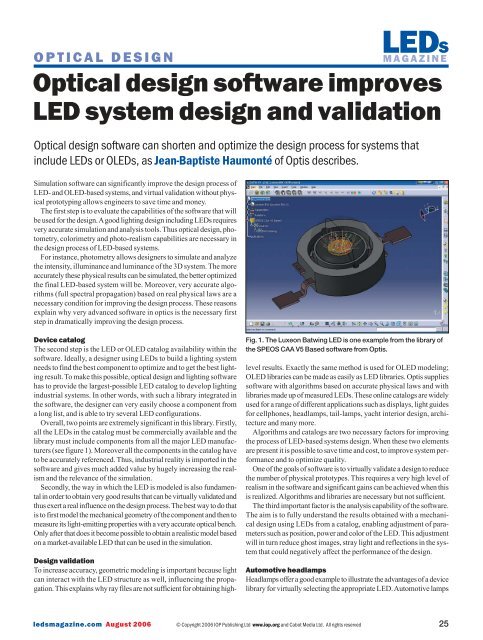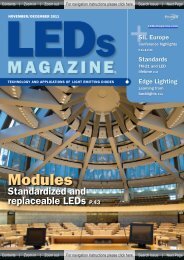LEDs Magazine Review - Beriled
LEDs Magazine Review - Beriled
LEDs Magazine Review - Beriled
- No tags were found...
Create successful ePaper yourself
Turn your PDF publications into a flip-book with our unique Google optimized e-Paper software.
OPTICAL DESIGNOptical design software improvesLED system design and validationSimulation software can significantly improve the design process ofLED- and OLED-based systems, and virtual validation without physicalprototyping allows engineers to save time and money.The first step is to evaluate the capabilities of the software that willbe used for the design. Agood lighting design including <strong>LEDs</strong> requiresvery accurate simulation and analysis tools. Thus optical design, photometry,colorimetry and photo-realism capabilities are necessary inthe design process of LED-based systems.For instance, photometry allows designers to simulate and analyzethe intensity, illuminance and luminance of the 3D system. The moreaccurately these physical results can be simulated, the better optimizedthe final LED-based system will be. Moreover, very accurate algorithms(full spectral propagation) based on real physical laws are anecessary condition for improving the design process. These reasonsexplain why very advanced software in optics is the necessary firststep in dramatically improving the design process.LEDSMAGAZINEOptical design software can shorten and optimize the design process for systems thatinclude <strong>LEDs</strong> or O<strong>LEDs</strong>, as Jean-Baptiste Haumonté of Optis describes.Device catalogThe second step is the LED or OLED catalog availability within thesoftware. Ideally, a designer using <strong>LEDs</strong> to build a lighting systemneeds to find the best component to optimize and to get the best lightingresult. To make this possible, optical design and lighting softwarehas to provide the largest-possible LED catalog to develop lightingindustrial systems. In other words, with such a library integrated inthe software, the designer can very easily choose a component froma long list, and is able to try several LED configurations.Overall, two points are extremely significant in this library. Firstly,all the <strong>LEDs</strong> in the catalog must be commercially available and thelibrary must include components from all the major LED manufacturers(see figure 1). Moreover all the components in the catalog haveto be accurately referenced. Thus, industrial reality is imported in thesoftware and gives much added value by hugely increasing the realismand the relevance of the simulation.Secondly, the way in which the LED is modeled is also fundamentalin order to obtain very good results that can be virtually validated andthus exert a real influence on the design process. The best way to do thatis to first model the mechanical geometry of the component and then tomeasure its light-emitting properties with a very accurate optical bench.Only after that does it become possible to obtain a realistic model basedon a market-available LED that can be used in the simulation.Fig. 1. The Luxeon Batwing LED is one example from the library ofthe SPEOS CAA V5 Based software from Optis.Design validationTo increase accuracy, geometric modeling is important because lightcan interact with the LED structure as well, influencing the propagation.This explains why ray files are not sufficient for obtaining highlevelresults. Exactly the same method is used for OLED modeling;OLED libraries can be made as easily as LED libraries. Optis suppliessoftware with algorithms based on accurate physical laws and withlibraries made up of measured <strong>LEDs</strong>. These online catalogs are widelyused for a range of different applications such as displays, light guidesfor cellphones, headlamps, tail-lamps, yacht interior design, architectureand many more.Algorithms and catalogs are two necessary factors for improvingthe process of LED-based systems design. When these two elementsare present it is possible to save time and cost, to improve system performanceand to optimize quality.One of the goals of software is to virtually validate a design to reducethe number of physical prototypes. This requires a very high level ofrealism in the software and significant gains can be achieved when thisis realized. Algorithms and libraries are necessary but not sufficient.The third important factor is the analysis capability of the software.The aim is to fully understand the results obtained with a mechanicaldesign using <strong>LEDs</strong> from a catalog, enabling adjustment of parameterssuch as position, power and color of the LED. This adjustmentwill in turn reduce ghost images, stray light and reflections in the systemthat could negatively affect the performance of the design.Automotive headlampsHeadlamps offer a good example to illustrate the advantages of a devicelibrary for virtually selecting the appropriate LED. Automotive lampsledsmagazine.com August 2006© Copyright 2006 IOP Publishing Ltd www.iop.org and Cabot Media Ltd. All rights reserved25
















